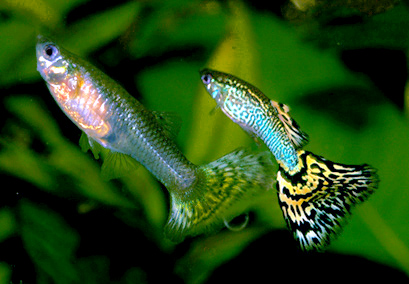In the United States, our own common and pugnacious species, the Mosquitofish (Gambusia affinis & holbrooki) also hail from this family.
The following images of a Guppy and Platy are of specimens from the aquarium trade, while the Mosquitofish is in its native and wild glory.

Guppy (Poecilia reticulata), female on left, male on the right.

Play (Xiphophous maculatus), male.

Western Mosquitofish (Gambusia affinis), male.
These fishes make easy-to-keep aquarium dwellers and almost automatically breed in most any tolerable aquarium conditions.
The Platy and Swordtail, members of the genus Xiphophorus, are, in the captive aquarium fish trade, rather hybridized. This is the case to the point that often in the aquarium trade the only thing to distinguish these three main "species," is that a Swordtail has a pointy extension to the caudal fin, and the Platies do not, with the variatus Platy being a bit longer than the standard maculatus specimen. The genetics of these Central American species are mixed to a staggering degree.
That brings us to today's unique website. The members of this genus are easily to keep, readily cross-breed, have many generations in a short time, and have distinctive external features. All of these traits make them ideal for genetic studies. The following link if for a whole lab based on the live-bearing fish of the genus Xiphophorus, maintained for the purposes of genetic studies. Notice how plain the very same species of the aquarium trade are in their wild genetic forms. Enjoy!
http://www.xiphophorus.txstate.edu/
Today is a great day to look back over the genetics of Gregor Mendel (+1884)!

Figure 1: Dominant and recessive phenotypes.
(1) Parental generation. (2) F1 generation. (3) F2 generation. Dominant (red) and recessive (white) phenotype look alike in the F1 (first) generation and show a 3:1 ratio in the F2 (second) generation.
[This last figure and caption from wikipedia.]
Live well!
No comments:
Post a Comment